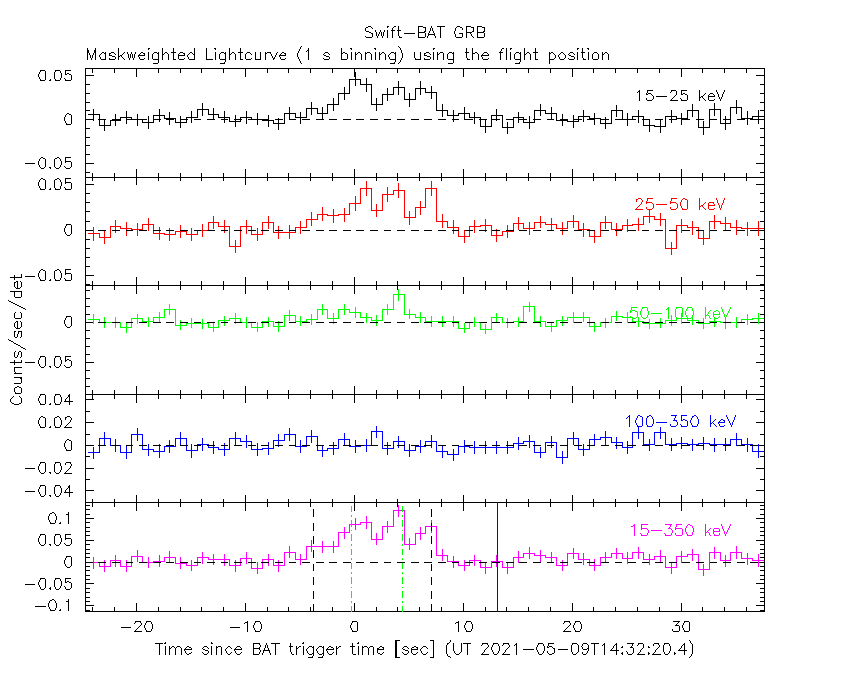
K.L. Page (U. Leicester), J.A. Kennea (PSU) and N.P.M. Kuin (UCL-MSSL) for the Swift team
At 14:32:20 UT, the Swift Burst Alert Telescope (BAT) triggered and located a GRB 210509A (trigger= 1047531) (Page et al. GCN Circ. 29970). Swift did not slew immediately due to an observing constraint. At the time of the trigger, the initial BAT position was 56° from the Sun (3.7 hours West) and 34° from the 4%-illuminated Moon. Table 1 contains the best reported positions from Swift, and the latest XRT position can be viewed at http://www.swift.ac.uk/xrt_positions.
Table 2 is a summary of GCN Circulars about this GRB from observatories other than Swift.
Standard analysis products for this burst are available at https://gcn.gsfc.nasa.gov/swift_gnd_ana.html.
As reported by Lien et al. (GCN Circ. 29975),
the BAT ground-calculated position is RA, Dec = 350.363, 6.650 deg which is RA(J2000) = 2
The mask-weighted light curve (Figure 1) shows several overlapping pulses that start at ~T-2 s and end at ~T+8 s.
The burst went out of the BAT FOV at ~T+77 s.
The time-averaged spectrum from T-1.65 to T+7.63 s is best fit by a power law with an exponential cutoff.
This fit gives a photon index 0.76 ± 1.00, and
The results of the batgrbproduct analysis are available at https://gcn.gsfc.nasa.gov/notices_s/1047531/BA/.
Analysis of the initial XRT data was reported by Kennea et al. (GCN Circ. 29977). We have analysed 9.8 ks of XRT data for GRB 210509A, from 3.2 ks to 79.5 ks after the BAT trigger. The data are entirely in Photon Counting (PC) mode. The enhanced XRT position for this burst was given by Goad et al. (GCN Circ. 29973).
The light curve (Figure 2) can be modelled with a power-law decay with a decay index of α=1.12 (+0.17, -0.15).
A spectrum formed from the PC mode data can be fitted with an absorbed power-law with a photon spectral index of 1.63 (+0.36, -0.16). The best-fitting absorption column is consistent with the Galactic value of 7.1 x 1
A summary of the PC-mode spectrum is thus:
Total column: 7.1 ± 8.9 x 1
Galactic foreground: 7.1 x 1
Excess significance: <1.6 σ
Photon index: 1.63 (+0.36, -0.16)
The results of the XRT team automatic analysis are available at http://www.swift.ac.uk/xrt_products/01047531.
The Swift/UVOT began settled observations of the field of GRB 210509A 3202 s after the BAT trigger
(Kuin and Page GCN Circ. 29978).
No optical afterglow consistent with the XRT position (Evans et al. GCN Circ. 29971) is detected in the initial UVOT exposures.
Table 3 gives preliminary
magnitudes using the UVOT photometric system
(Breeveld et al. 2011, AIP Conf. Proc., 1358, 373).
No correction has been made for the expected extinction in the Milky Way
corresponding to a reddening of

Figure 1. The BAT
mask-weighted light curve in the four individual and total
energy bands. The units are counts

Figure 2. The XRT light curve.
Any data from a crosshatched region are not included in the fit.
| RA (J2000) | Dec (J2000) | Error | Note | Reference |
|---|---|---|---|---|
| 2 |
+06°40'16.5" | 2.5" | XRT-final | UKSSDC |
| 2 |
+06°40'16.5" | 2.5" | XRT-enhanced | Goad et al. GCN Circ. 29973 |
| 2 |
+06°39'01.1" | 1.5' | BAT-refined | Lien et al. GCN Circ. 29975 |
| Band | Authors | GCN Circ. | Subject | Observatory | Notes |
|---|---|---|---|---|---|
| Optical | Sun et al. | 29972 | BOOTES-4/MET optical upper limit | BOOTES-4 | upper limits |
| Optical | Lipunov et al. | 29974 | Swift GRB 210509A: Global MASTER-Net observations report |
MASTER | |
| Optical | Watson et al. | 29979 | RATIR Optical and NIR Upper Limits | RATIR | upper limits |
| Filter | Exp(s) | Mag | ||
|---|---|---|---|---|
| whit |
3202 | 3352 | 147 | >20.8 |
| white | 3202 | 4585 | 344 | >21.0 |
| v | 3358 | 4934 | 332 | >19.0 |
| b | 4180 | 4380 | 197 | >19.5 |
| u | 3974 | 4174 | 197 | >19.6 |
| w1 | 3769 | 3969 | 197 | >19.5 |
| m2 | 3563 | 3763 | 197 | >20.3 |
| w2 | 4592 | 4792 | 197 | >19.6 |
Table 3. UVOT observations reported by Kuin and Page (GCN Circ. 29978). The start and stop times of the exposures are given in seconds since the BAT trigger. The preliminary 3-σ upper limits are given. No correction has been made for extinction in the Milky Way.
May 11, 2021